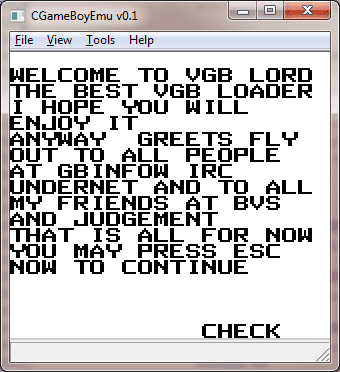Gameboy Emulation
This is just a page with a few notes that somebody may find useful. I hope to develop it as time goes by.
Assembly Example
First off, I downloaded a very simple ROM file, which was a file called ‘VGB Lord Demo (PD).gb’, and has been instrumental in the testing of an emulator I’ve been developing.
The ROM weighs in at 32,768 bytes, however, a mere 1,536 bytes are actually used, which is definitely a good thing for testing purposes!
The breakdown is like this:
- 0x000 to 0x1BF – 448 bytes of opcodes
- 0x1C0 to 0x3BF – 512 bytes of tile (image) data
- 0x3C0 to 0x5FF – 576 bytes of tile map data
At offset byte #402 within the ROM, the following sequence for loading the tiles into memory occurs:
#1) 21 00 80 ld hl, 8000 <- 0x8000 is the video memory location
#2) 01 C0 01 ld bc, 01C0 <- 0x1C0 is the location in the ROM for the tile data
#3) 16 00 ld d, 00 <- Loads the value 0x00 into Register D \*
#4) 1E 02 ld e, 02 <- Loads the value 0x02 into Register E \*\*
#5) 0A ld a, \[bc\] <- Load the value at BC into A
#6) 22 ldi \[hl\], a <- Load into location at HL the value of A and increment value
#7) 03 inc bc <- Increment BC
#8) 15 dec d <- Decerement D
<- Z Flag gets set if result equals 0)
<- N Flag gets set anyway)
<- H Flag set if no borrow from bit 4)
<- C Flag Unaffected)
#9) C2 9C 01 jp nz, 019C <- Jumps to 0x19C in ROM if Z == 0 (Meaning D != 0 yet)
#10) 1D dec e <- Decrement E (Flags set as previously mentioned)
#11) C2 9C 01 jp nz, 019C <- Jumps to 0x19C in ROM if Z == 0 (Meaning E != 0 yet)
#12) C9 ret <- Returns back to where this loading function was called-
Register D starts from 0, and when decremented, will wrap around to 255, thus allowing it to count down to 0 allowing the 256 values
-
Register E is set to 2 and allows the loop to run through a second iteration with D counting down to 0 once again allowing for a total loop of 512 long (2 (E) x 256 (D) = 512)
Given these structures:
rom_data[32768];
mem_data[32768];In C, with access to values greater than 8-bit (for values above 255), that chunk of assembly is as simple as this:
for (int i = 0; i < 512; i++)
{
mem_data[0x8000 + i] = rom_data[0x1C0 + i];
}




